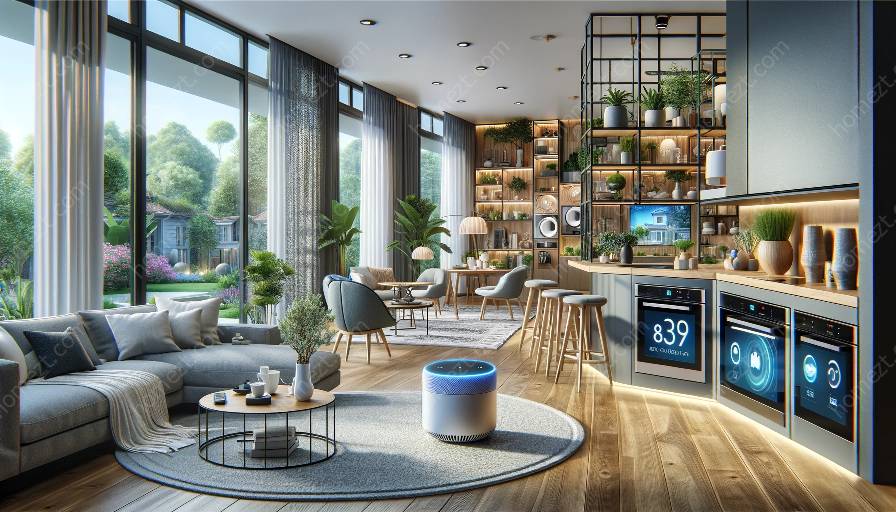Voice-controlled home appliances have become integral parts of modern intelligent home designs, offering unparalleled convenience and efficiency. However, ensuring smooth operation and maximizing the lifespan of these devices require proper troubleshooting and maintenance. This comprehensive guide will explore essential tips and techniques to address common issues, perform regular upkeep, and optimize the performance of your voice-controlled home appliances.
Understanding Voice-Controlled Home Appliances
To effectively troubleshoot and maintain voice-controlled home appliances, it's crucial to grasp their fundamental operations and integration within an intelligent home design. These devices, such as smart speakers, thermostats, and lighting systems, rely on voice commands and connectivity to execute tasks and enhance home automation. As these appliances continue to evolve, they offer features such as voice recognition, remote access, and compatibility with virtual assistants like Amazon Alexa, Google Assistant, and Apple's Siri.
Common Troubleshooting Scenarios
Despite their advanced technology, voice-controlled appliances may encounter various issues that could disrupt their functionality. Common troubleshooting scenarios include connection problems, unresponsiveness to voice commands, software glitches, and integration issues with other smart devices. It's essential to understand the causes behind these issues and learn effective troubleshooting methods to rectify them promptly.
Connection Problems:
- Check Wi-Fi Signal Strength: Weak Wi-Fi signals can hinder the communication between the voice-controlled appliance and your home network. Positioning the device closer to the router or installing a Wi-Fi extender may improve the signal strength.
- Router Reboot: Restarting your router can resolve temporary connectivity issues and ensure a stable connection with the voice-controlled appliance.
Voice Command Unresponsiveness:
- Training Voice Recognition: If the appliance consistently fails to recognize your voice commands, consider retraining the voice model within the device's settings. This process can enhance accuracy and responsiveness.
- Environmental Factors: Excessive background noise or echoes in the environment can affect the appliance's ability to interpret voice commands. Minimizing noise and optimizing the device's microphone sensitivity settings can mitigate these issues.
Software Glitches:
Periodic software updates for voice-controlled appliances ensure optimal performance and address known bugs and vulnerabilities. Keep the devices' firmware up to date by following the manufacturer's recommended update procedures. Additionally, performing a factory reset can resolve persistent software-related issues.
Integration Issues:
When voice-controlled appliances fail to integrate seamlessly with other smart devices in your home, verify compatibility and ensure all devices are updated to their latest software versions. Reviewing the devices' compatibility lists and resetting their connections can often resolve integration challenges.
Effective Maintenance Practices
Regular maintenance is essential to prolong the longevity and performance of voice-controlled home appliances. By incorporating simple yet impactful maintenance practices, you can ensure these devices continue to operate seamlessly within your intelligent home ecosystem.
Device Cleaning:
Regularly clean the surfaces and microphones of voice-controlled appliances to prevent dust and debris accumulation, which can impede their functionality. Utilize soft, microfiber cloths and gentle cleaning solutions recommended by the device manufacturer.
Environmental Considerations:
Place voice-controlled appliances away from direct sunlight, moisture, and extreme temperatures to prevent damage and maintain their operational integrity. Environmental factors can significantly impact the performance and lifespan of these devices.
Power Management:
Adopt efficient power management practices by unplugging or powering down voice-controlled appliances when they are not in use. This approach can reduce energy consumption and contribute to the devices' long-term reliability.
Regular Performance Checks:
Conduct routine performance checks to verify the functionality of voice-controlled appliances, including voice recognition accuracy, responsiveness, and integration with other smart devices. Identify and address any emerging issues promptly.
Optimizing Performance and Integration
Enhance the overall performance and integration of voice-controlled home appliances by exploring advanced troubleshooting techniques and optimizing their functionalities.
Advanced Settings Configuration:
Dive into the advanced settings of your voice-controlled appliances to customize features such as voice sensitivity, language preferences, and voice model training. Tailoring these settings can enhance the devices' responsiveness and adaptability to your specific environment.
Network Optimization:
Optimize your home network by prioritizing the bandwidth for voice-controlled appliances and ensuring a robust, stable connection. Implementing mesh Wi-Fi systems or network extenders can further enhance the devices' connectivity and reduce potential performance issues.
Integration with Smart Home Devices:
Exploit the full potential of voice-controlled appliances by seamlessly integrating them with other smart home devices, such as security cameras, smart locks, and entertainment systems. Go through the integration process for each device, ensuring smooth communication and centralized control.
Conclusion
Embracing the troubleshooting and maintenance of voice-controlled home appliances is imperative to harness their full potential within an intelligent home design. By understanding common issues, implementing effective troubleshooting strategies, and practicing regular maintenance, you can ensure these devices operate flawlessly and contribute to an enhanced, interconnected living environment.


